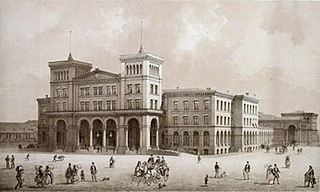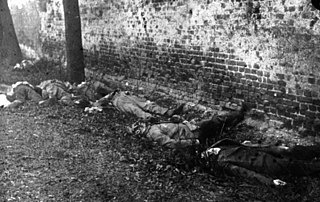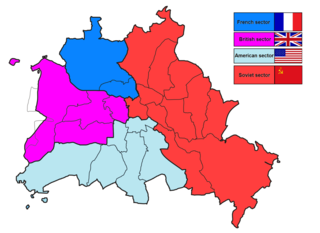 W
WDer Angriff is a discontinued German language newspaper founded in 1927 by the Berlin Gau of the Nazi Party. The last edition was published on 24 April 1945.
 W
WThe Berlin Air Safety Centre (BASC) was established by the Allied Control Authority Coordinating Committee on 12 December 1945. Operations began in February 1946 under quadripartite flight rules Paragraph 4. Paragraph 4 of the rules begins: "The Berlin Air Safety Centre has been established in the Allied Control Authority Building with the object of ensuring safety of flights for all aircraft in the Berlin area. BASC regulates all flying in the Berlin control zone and also in the corridors extending from Berlin to the boundaries of adjacent control zones."
 W
WThe Berlin Document Center (BDC) was created in Berlin, Germany, after the end of World War II. Its task was to centralize the collection of documents from the time of Nazism, which were needed for the preparation of the Nuremberg Trials against war criminals. The BDC was under American administration until 1994, when the German Federal Archives (Bundesarchiv) was allowed to take control of the BDC. While the paper records remained in Germany, the entire collection was microfilmed and made available at the National Archives in Washington, DC, where researchers have much better access unhindered by restrictive German privacy laws now in effect in Berlin.
 W
WGörlitzer Bahnhof was the name of the Berlin railway terminus for the mainline link between the capital, Cottbus in Brandenburg and Görlitz in Lower Silesia. It stood overlooking Spreewaldplatz in the Outer Luisenstadt, the eastern part of Kreuzberg but wartime bombing and Cold War tensions led to its closure and eventual demolition.
 W
WThe Berlin March Battles of 1919 were the final decisive phase of the German Revolution of 1918–1919. The events were the result of a general strike by the Berlin working class to enforce the widely anticipated socialization of key industries, as well as the legal safeguarding of the workers' and soldiers' councils and thus the democratization of the military. The strike action was met with violence from the paramilitary Freikorps, resulting in street fighting and house-to-house fighting around the Alexanderplatz and the city of Lichtenberg.
 W
WBerlin Sportpalast was a multi-purpose indoor arena located in the Schöneberg section of Berlin, Germany. Depending on the type of event and seating configuration, the Sportpalast could hold up to 14,000 people and was for a time the biggest meeting hall in Berlin. The Sportpalast is most known for speeches and rallies that took place during the Third Reich, particularly Nazi Propaganda Minister Joseph Goebbels's 1943 "Total War" speech.
 W
WThe Berlin Wall was a guarded concrete barrier that physically and ideologically divided Berlin from 1961 to 1989. Construction of the wall was commenced by the German Democratic Republic on 13 August 1961. The Wall cut off West Berlin from surrounding East Germany, including East Berlin. The barrier included guard towers placed along large concrete walls, accompanied by a wide area that contained anti-vehicle trenches, beds of nails and other defenses. The Eastern Bloc portrayed the Wall as protecting its population from fascist elements conspiring to prevent the "will of the people" from building a socialist state in East Germany.
 W
WThe former Britannia Centre Spandau, previously known as British Forces Families Centre (BFFC), was built in 1990 by the PSA for the British Authorities on the site where Spandau Prison was once located.
 W
WThis article lists the military commanders of divided and war torn Berlin between 1945 and 1994. Following the end of World War II in Europe, the Allies divided Berlin into distinct, occupied sectors, each had its own military governor, often referred to as commandant. This practice ended officially with the German reunification in 1990, but the several military commanders were in place until as late as 1994, when the respective occupying/protective forces were withdrawn, according to the Treaty on the Final Settlement with Respect to Germany.
 W
WThe Detlev-Rohwedder-Haus is a building in Berlin that, at the time of its construction, was the largest office building in Europe. It was constructed between February 1935 and August 1936 to house the German Ministry of Aviation, headed by Hermann Göring, a leading Nazi.
 W
WThe Reich President's Palace was from 1919 to 1934 an official residence of the President of the Reich and the official seat of the German head of state.
 W
WPension Clausewitz was a luxury West Berlin brothel. In 1965 it was the centre of an alleged spying scandal, that when investigated, was unfounded.
 W
WKnown for most of its operational life as Royal Air Force Gatow, or more commonly RAF Gatow, this former British Royal Air Force station is in the district of Gatow in south-western Berlin, west of the Havel river, in the borough of Spandau. It was the home for the only known operational use of flying boats in central Europe, and was later used for photographic reconnaissance missions by de Havilland Canada DHC-1 Chipmunks over East Germany. Part of the former airfield is now called General Steinhoff-Kaserne, and is home to the Luftwaffenmuseum der Bundeswehr, the German Air Force Museum.
 W
WThe Reich Chancellery was the traditional name of the office of the Chancellor of Germany in the period of the German Reich from 1878 to 1945. The Chancellery's seat, selected and prepared since 1875, was the former city palace of Prince Antoni Radziwiłł (1775–1833) on Wilhelmstraße in Berlin. Both the palace and a new Reich Chancellery building were seriously damaged during World War II and subsequently demolished.
 W
WThe Volkshalle, also called Große Halle or Ruhmeshalle, was a monumental domed building planned by Adolf Hitler and his architect Albert Speer for Germania in Berlin. The project was never realized.